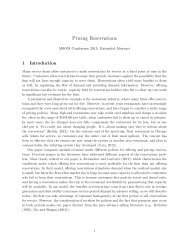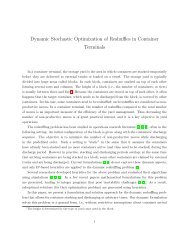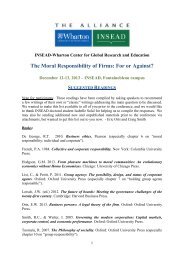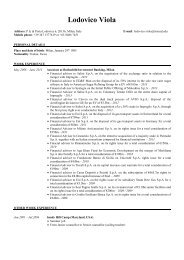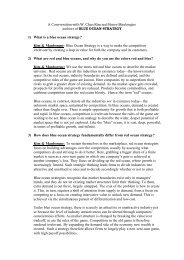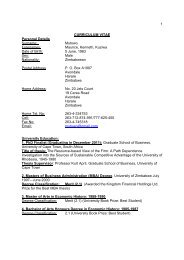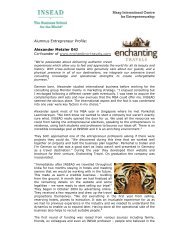RESPONSE - Insead
RESPONSE - Insead
RESPONSE - Insead
Create successful ePaper yourself
Turn your PDF publications into a flip-book with our unique Google optimized e-Paper software.
Findings: External factors and cognitive alignment (Objective 2) The impact of geography on the size of<br />
cognitive gaps<br />
5.5 The impact of geography on the size of cognitive gaps<br />
The impact of the geographic location a company’s headquarters could influence the magnitude of<br />
cognitive gaps for different reasons. On the one hand, the amount of pressure by stakeholders, and<br />
their degree of sophistication, can vary depending on the cultural traits, social norms and legal<br />
boundaries present in a given region. In more advanced regions, such as Northern Europe 12 one<br />
would expect lower gaps because of the longer history of interaction between the companies and their<br />
stakeholders. At the same time, though, stakeholder demand itself might evolve more rapidly in the<br />
most advanced regions making it harder for managers to maintain a high level of cognitive alignment.<br />
A starting hypothesis, therefore, would be that Northern Europe would exhibit lower gaps than<br />
Southern Europe, and that European companies would have lower gaps than Anglo Saxon countries,<br />
based on the higher levels of sophistications of companies in that region. However, if the stakeholder<br />
sophistication effect is prevalent, i.e. stakeholders demonstrate more sophisticated demands in<br />
advanced regions, then the sequence of the three regions would be the opposite: Anglo Saxon<br />
countries would have smaller gaps than Europe, since stakeholders there might be even less<br />
sophisticated or complex to manage than in Europe.<br />
The average gaps across all the companies in each of the three regions is presented in Table 18.<br />
Table 18. Cognitive gaps by geography (all companies)<br />
60%<br />
40%<br />
20%<br />
0%<br />
Gap 1 Gap 2 Gap 3 Gap 4<br />
N.Europe 26% 35% 46% 10%<br />
S.Europe 28% 28% 37% 0%<br />
Anglo Saxons 22% 21% 27% 1%<br />
The evidence suggests a series of somewhat unexpected findings:<br />
1. Managers in AngloSaxon companies exhibit the lowest Sequential, Risk Ranking and<br />
Responsibility Ranking gaps, and therefore the larger degree of alignment, compared<br />
to Southern European companies and even more compared to Northern European<br />
companies.<br />
2. Northern European companies also seem to misjudge (specifically, overstate) their<br />
own social performance more than Southern European and AngloSaxon companies,<br />
which are essentially on target visàvis their stakeholders’ assessments.<br />
It appears that the effect related to the sophistication of stakeholders is stronger than that of the<br />
corporate managers, thereby penalising apparently experienced companies based in Northern<br />
Europe. However, the fact that Northern European companies also overstate their estimates of social<br />
performance confirms that there might also be an excessive amount of praise for the northern<br />
European companies, compared to those headquartered in AngloSaxon countries and Southern<br />
Europe.<br />
A further explanation for the surprising finding may be related to our hypothesis that dynamic<br />
industries are characterised by higher alignment than stable industries. In the same way, firms in<br />
regions marked by faster economic change (e.g. North America and the UK) are associated with<br />
12 Northern European countries typically score the highest in terms of CSP of their companies (CITE<br />
Responsible Competitiveness study by Accountability)<br />
<strong>RESPONSE</strong>: understanding and responding to societal demands on corporate responsibility<br />
49



